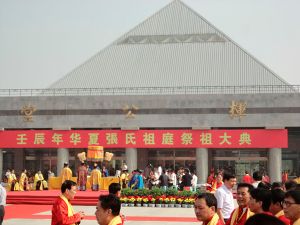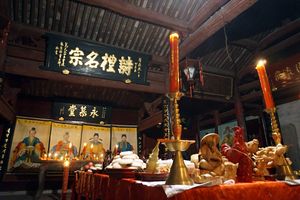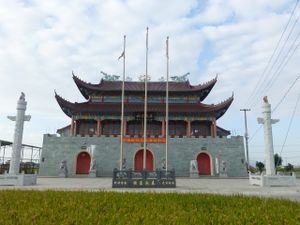تبجيل السلف في الصين
| جزء من سلسلة عن |
| الديانة الشعبية الصينية |
|---|
 |
| بوابة الديانة الشعبية الصينية |
عبادة السلف الصينية أو تبجيل السلف في الصين، وتسمى أيضاً الديانة الأبوية الصينية،[1] is an aspect of the Chinese traditional religion which revolves around the ritual celebration of the deified ancestors and tutelary deities of people with the same surname organised into lineage societies in ancestral shrines. Ancestors, their ghosts, or spirits, and gods are considered part of "this world", that is, they are neither supernatural (in the sense of being outside nature) nor transcendent in the sense of being beyond nature. The ancestors are humans who have become godly beings, beings who keep their individual identities. For this reason, Chinese religion is founded on veneration of ancestors.[2] Ancestors are believed to be a means of connection to the supreme power of Tian as they are considered embodiments or reproducers of the creative order of Heaven.[3]
Confucian philosophy calls for paying respect to one's ancestors, an aspect of filial piety; Zhuo Xinping (2011) views traditional patriarchal religion as the religious organisation complementing the ideology of Confucianism.[4] As the "bedrock faith of the Chinese", traditional patriarchal religion influences the religious psychology of all Chinese and has influenced the other religions of China,[5] as it is evident in the worship of founders of temples and schools of thought in Taoism and Chinese Buddhism.
Ancestor veneration practices prevail in south China, where lineage bonds are stronger and the patrilineal hierarchy is not based upon seniority, and access to corporate resources held by a lineage is based upon the equality of all the lines of descent;[6] whereas in north China worship of communal deities is prevalent.[7]
التعريف

Some contemporary scholars in China have adopted the names "Chinese traditional patriarchal religion" (中國傳統宗法性宗教 Zhōngguó chuántǒng zōngfǎ xìng zōngjiào) or "Chinese traditional primordial religion" (中國傳統原生性宗教 Zhōngguó chuántǒng yuánshēng xìng zōngjiào) to define the traditional religious system organised around the worship of ancestor-gods.[8][9]
العادات

الطقوس الجنائزية
الدفن
المراجع
الهامش
- ^ Zhou (2003), p. 42.
- ^ Nadeau (2010), p. 369.
- ^ Yao & Zhao (2010), pp. 113–116.
- ^ Yang & Tamney (2011), p. 281.
- ^ He (2012).
- ^ Wu (2014), p. 20. Quote: «[...] southern China refers to Fujian and Guangdong province and in some cases is expanded to include Guangxi, Zhejiang and Jiangxi provinces. Historically speaking, these areas had the strong lineage organizations and the territorial cult, compared to the rest of China in the late imperial period. These areas not only were the first to revive lineage and the territorial cult in the reform era, but also have the intensity and scale of revivals that cannot be matched by the other part of China. This phenomena is furthered referred as the southern model, based on the south-vs.-north model. The north model refers to the absence of landholding cooperative lineages that exist in the south.» Note 16: The south-vs.-north model comparison has been the thrust of historical and anthropological research. Cohen’s article on “Lineage organization in North China (1990)” offers the best summary on the contrast between the north model and the south model. He calls the north China model “the fixed genealogical mode of agnatic kinship.” By which, he means “patrilineal ties are figured on the basis of the relative seniority of descent lines so that the unity of the lineage as a whole is based upon a ritual focus on the senior descent line trace back to the founding ancestor, his eldest son, and the succession of eldest sons.” (ibid: 510) In contrast, the south China model is called “the associational mode of patrilineal kinship.” In this mode, all lines of descent are equal. “Access to corporate resources held by a lineage or lineage segment is based upon the equality of kinship ties asserted in the associational mode.” However, the distinction between the north and the south model is somewhat arbitrary. Some practices of the south model are found in north China. Meanwhile, the so-call north model is not exclusive to north China. The set of characteristics of the north model (a distinctive arrangement of cemeteries, graves, ancestral scrolls, ancestral tablets, and corporate groups linked to a characteristic annual ritual cycle) is not a system. In reality, lineage organizations display a mixture between the south and the north model.»
- ^ Overmyer (2009). "As for the physical and social structure of villages on this vast flat expanse; they consist of close groups of houses built on a raised area, surrounded by their fields, with a multi-surnamed population of families who own and cultivate their own land, though usually not much more than twenty mou or about three acres. [...] Families of different surnames living in one small community meant that lineages were not strong enough to maintain lineage shrines and cross-village organizations, so, at best, they owned small burial plots and took part only in intra-village activities. The old imperial government encouraged villages to manage themselves and collect and hand over their own taxes. [...] leaders were responsible for settling disputes, dealing with local government, organizing crop protection and planning for collective ceremonies. All these factors tended to strengthen the local protective deities and their temples as focal points of village identity and activity. This social context defines North China local religion, and keeps us from wandering off into vague discussions of ‘popular’ and ‘elite’ and relationships with Daoism and Buddhism."
- ^ Zhang Jin, Yang Chunpeng. “中国传统原生性宗教”的产生和特点 ("Chinese traditional primordial religion": generation and characteristics). China Ethnic and Religious Network (中国民族宗教网), 2013. Archived 2016-03-04 at the Wayback Machine
- ^ China Confucius Network: 人文主义宗教与宗教人文主义 Archived 2016-03-04 at the Wayback Machine
المصادر
- He, Qimin (2012). "Religious Traditions in Local Communities of China". Pastoral Psychology. 61 (5): 823–839. doi:10.1007/s11089-012-0438-z. ISSN 0031-2789.
{{cite journal}}: Invalid|ref=harv(help) - Nadeau, Randall (2010). "Divinity". In Nadeau, Randall L. (ed.). The Wiley-Blackwell Companion to Chinese Religions. ISBN 9781444361971.
{{cite encyclopedia}}: Invalid|ref=harv(help) - Overmyer, Daniel L. (2009). Local Religion in North China in the Twentieth Century: The Structure and Organization of Community Rituals and Beliefs (PDF). Leiden; Boston: Brill. ISBN 9789047429364. Archived from the original (PDF) on 2015-06-16. Retrieved 2016-01-17.
{{cite book}}: Invalid|ref=harv(help); Unknown parameter|dead-url=ignored (|url-status=suggested) (help) - Wu, Hsin-Chao (2014). "Local Traditions, Community Building, and Cultural Adaptation in Reform Era Rural China" (PDF). Harvard University.
{{cite journal}}: Cite journal requires|journal=(help); Invalid|ref=harv(help) - Yao, Xinzhong; Zhao, Yanxia (2010). Chinese Religion : A Contextual Approach. London: New York: Continuum. ISBN 9781847064752.
{{cite book}}: Invalid|ref=harv(help) - Zhou, Jinghao (2003). Remaking China's Public Philosophy for the Twenty-first Century. Greenwood Publishing Group. ISBN 978-0275978822.
{{cite book}}: Invalid|ref=harv(help) - Zhuo Xinping, "Spiritual Accomplishment in Confucianism and Spiritual Transcendence in Christianity," in Yang, Fenggang; Tamney, Joseph, eds. (2011). Confucianism and Spiritual Traditions in Modern China and Beyond. BRILL. ISBN 978-9004212398.
{{cite book}}: Invalid|ref=harv(help)



